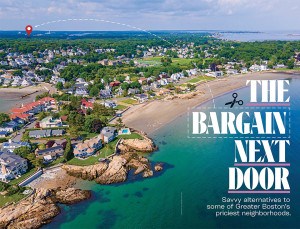The Battle of James Island
Tom Killilea is no stranger to conflict in Inner Little Harbor. Around 2011, he formed a group called the Environmental 20, or E20, to protest a change to how often three tidal gates, known as the Cat Dam, should open in the summer, flushing the harbor with saltwater from the Atlantic Ocean.
The dispute grew into a full-blown coup at Town Hall. Selectmen ultimately voted 3 to 2 to replace three longtime members of the Conservation Commission with three relatively inexperienced newcomers who wouldn’t be able to vote on Cat Dam. Selectman Ted Carr said he was “very disappointed that a very well-organized single-issue special interest group has been able to join the Conservation Commission.”
“This is a war,” Killilea told the Boston Globe at the time.
“These people that have lived there…they fought a very expensive and long-winded lawsuit about how the water flow should be in there,” says Tony DiPaolo, an Inner Little Harbor resident of three years. “And what happened is, lo and behold, it became absolutely pristine.… So when anybody’s going to do something that could potentially harm it, they’re going to be very, very, very thorough in their examination.”
Originally, DiPaolo believed the Steinmetzes should be able to build on James Island, but within the law. “I’ve always said that to John and Jane,” he says. “Hell, I had them as guests at a $1,000-a-plate charity dinner when we had the gala to raise money for the arts center. I’m on the board of directors of the South Shore Arts Center. Ten-thousand-dollar table. I’m just saying, I try to be equal.”
DiPaolo believes the Conservation Commission, headed by Creighton when it first took up the James Island matter, was merely doing its job, blending healthy skepticism with fierce protection of the town’s natural resources, and calls Creighton “an honorable, hard-working, good guy.”
“They did things the right way. They asked the right questions. They brought in the right experts, and they made a determination,” he says.
The Conservation Commission’s first public hearing on the James Island matter began with confusion about whether Creighton ought to recuse himself, given his prior concerns over sewer permitting on the island. Creighton said he conferred with town counsel, who determined there would be no issue with his participation. Vice chairman Patrick Kennedy asked to see the counsel’s written opinion, but Creighton asserted that he’d discussed the matter with the counsel verbally.
That exchange didn’t sit well with Steinmetz, who also demanded a copy of the written opinion. He filed two public-records requests, both with meticulous detail, hoping at least one of the many configurations of names and phrases would deliver unto him the opinion he sought. When the town finally processed Steinmetz’s overdue request, he says he received a cardboard box full of unrelated junk, which cost him $1,200. Town counsel’s opinion was nowhere to be found.
At the second meeting, on July 23, commissioners told Steinmetz that if he retained an environmental monitor during construction and paid for an expert to study potential impact on the storm-water runoff, the project would gain approval. So he did. And Mark Bartlett, the Conservation Commission’s own storm-water expert, gave it a thumbs up.
Even so, by the third meeting on the matter, Steinmetz says it became clear that the Conservation Commission had its mind made up against him. The panel rejected his plans 4 to 2 in September, claiming the driveway would be situated too close to the wetlands, endangering the fragile salt marsh. “We literally had the wetlands bylaw in front of us,” Creighton says. “There’s no way it’s going to be overturned.”
So Steinmetz began a barrage of legal complaints, some against individual members of the Conservation Commission. “He would have constables serve notices at their homes,” Creighton says. Meanwhile, the JIPG responded with a publicity blitz. A self-styled “active Cohasset citizen of 44 years,” James Marten recused himself from the Conservation Commission’s discussions over James Island. But in a November 7 piece in the Mariner, he called Steinmetz’s legal broadside a threat to self-government.
“How can we maintain a civil discourse and town self-government when committee volunteers fear retribution for carrying out the responsibilities they swore to uphold?” he wrote. “How do we continue the wonderful practice of self-government whilst preserving our environmental heritage which is under threat from over-development?”
Marten says that he and his wife have fought to keep the water in Inner Little Harbor clean since they moved to the neighborhood more than 40 years ago. “I have no idea how it would conclude, how it can conclude,” he says of the lengthy ordeal.
In a bureaucratic labor befitting of Gogol, Alexander Strysky, a state environmental analyst, rode into Cohasset and held an informational meeting on the James Island matter on January 7, 2016. The meeting, part of a state review of the project and advertised in the Quincy Patriot Ledger, sought to provide a forum for the residents’ concerns and lasted more than two hours. But its timing only further incensed residents, who claimed insufficient public notice, and argued that the Mariner, not the Patriot Ledger, was the proper paper of local circulation to broadcast such an event.
“Who gets the Ledger?” wrote Rustam Devitre, an Inner Little Harbor resident, in a January 11 email. “You should have it publicized on the Town Hall door or in the Mariner. These tactics are not fair to the public.”
So Strysky solicited written comments and established an email distribution list, which included members of both sides. But with each comment submitted to the list, Steinmetz promptly fired off an itemized rebuttal.
Steve and Margie Brown raised the issue of the least tern, a species of bird spotted around Inner Little Harbor. The least tern—picture a cross between a seagull and Massachusetts’ state bird, the black-capped chickadee—is considered a species of “special concern” in the Bay State, especially vulnerable to human disturbance. (The Mass Audubon’s entry on the birds notes that in self-defense, they have been known to “drop excrement upon intruders with accuracy.”)
“These least terns plunge-dive for food in Inner Little Harbor immediately around the undeveloped south end of James Island,” Steve Brown wrote. “Development of the island could endanger the ability of the least terns to nest.”
“I note that Mr. Brown’s comments are entirely unfounded,” Steinmetz replied. “In addition, we are not planning any development on Pleasant Beach to which Mr. Brown refers, as this beach is on the other side of Atlantic Avenue from our property.”
James McCann, the Ahold USA COO, called Steinmetz’s plans an “environmental nightmare,” while boasting about the more than 450 people who “liked” the JIPG’s Facebook page.
“The Steinmetz[es] are both experienced attorneys and hence knew perfectly well the risks they were taking on in proposing such a large development on the least suitable and most environmentally sensitive part of their site,” McCann wrote, suggesting that the couple build on the one-acre plot where a cracked, weed-ravaged tennis court is currently situated on the isthmus.
Steinmetz responded: “Mr. McCann fails to disclose that he is a corporate executive of a large foreign-owned supermarket chain, and that he has headed up the expansion and development efforts for his company in the United States. For him to now claim that he has concerns about a single-family house is beyond preposterous.”
Meanwhile, verdicts from state regulatory agencies rolled in, all expressing varying degrees of support for Steinmetz’s project. But the Conservation Commission reserves the right to have the final say.
Around this time, Cohasset’s town counsel admitted that there were documents related to the legal opinion provided to Creighton after all; Steinmetz begged the state supervisor of public records to reopen his appeal in light of this new information after the case was closed in December.
Two months after the commission’s vote to block the project, Steinmetz sued Coyle & Caron, a Florida-based landscape architecture design firm, for $6 million in damages, claiming that the rendering it supplied the JIPG had stoked resistance to the project.
To craft the rendering, the firm used all of the building plans Steinmetz submitted to Town Hall, as well as Google Earth overlays and photos taken by a person who kayaked into the harbor for reconnaissance. While the firm was aware that it had been hired by the project’s opposers, it claims protection under the Anti-SLAPP, or Strategic Litigation Against Public Participation, statute.
“The renderings didn’t cause any kind of damage. None whatsoever,” says Evan Fray-Witzer, Coyle & Caron’s attorney. “And in the motions and the oppositions that the Steinmetzes have filed, they seem to suggest now that their damages really stem from the fact that the rendering got posted by the preservation group on the preservation group’s Facebook page, and people ended up saying things about the proposed house that the Steinmetzes didn’t like, and that their reputations have been damaged as a result.”
In February, the American Civil Liberties Union of Massachusetts filed an amicus brief in support of Fray-Witzer’s motion to dismiss Steinmetz’s complaint. “Unless people are free, and feel free, to express themselves to the government, representative government loses its legitimacy. Accordingly, the right to petition is ‘among the most precious of the liberties safeguarded by the Bill of Rights,’” its counsel wrote.
With spring came a thaw in the Cohasset cold war. In a last-ditch effort to get his dream home built, Steinmetz announced he would withdraw without prejudice his three lawsuits (meaning they can be refiled) against the Conservation Commission and its members as a peace offering. Instead, he would submit revised plans to the body, this time with the contentious driveway at least 50 feet away from the salt marshes, putting it outside of the buffer zone.
Indeed, despite all the legal maneuvering, the thousands spent, and the mob assembled against him, John Steinmetz doesn’t want to live in his James Island dream home any less than when he and Jane first laid eyes on the craggy peninsula. Over the phone, I ask him, in the event he’s ever able to take up residence at One James Island Way, if he’ll throw a party with his new neighbors.
“I would certainly be open to inviting people over,” he says, choosing his words carefully. “There’s a lot of very hard feelings right now between people in town, but my hope is that we can put that behind us and move forward. I’m certainly willing to try on my end.”


